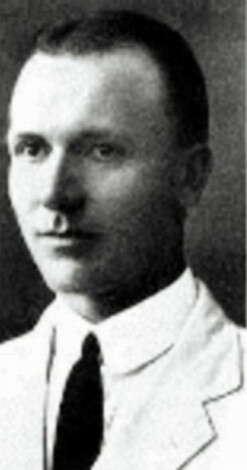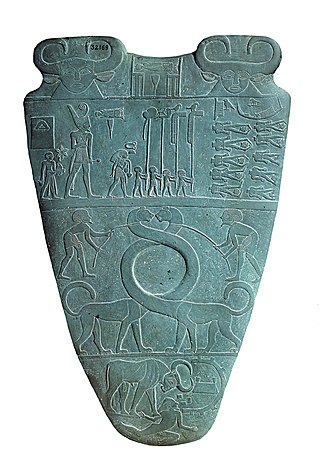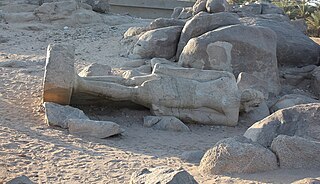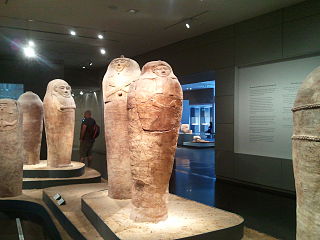Related Research Articles

Aten, also Aton, Atonu, or Itn was the focus of Atenism, the religious system formally established in ancient Egypt by the late Eighteenth Dynasty pharaoh Akhenaten. Exact dating for the Eighteenth Dynasty is contested, though a general date range places the dynasty in the years 1550 to 1292 BCE. The worship of Aten and the coinciding rule of Akhenaten are major identifying characteristics of a period within the Eighteenth Dynasty referred to as the Amarna Period.

Amarna is an extensive ancient Egyptian archaeological site containing the remains of what was the capital city during the late Eighteenth Dynasty. The city of Akhetaten was established in 1346 BC, built at the direction of the Pharaoh Akhenaten, and abandoned shortly after his death in 1332 BC. The name that the ancient Egyptians used for the city is transliterated as Akhetaten or Akhetaton, meaning "the horizon of the Aten".

Nefertiti was a queen of the 18th Dynasty of Ancient Egypt, the great royal wife of Pharaoh Akhenaten. Nefertiti and her husband were known for their radical overhaul of state religious policy, in which they promoted the earliest known form of monotheism, Atenism, centered on the sun disc and its direct connection to the royal household. With her husband, she reigned at what was arguably the wealthiest period of ancient Egyptian history. After her husband's death, some scholars believe that Nefertiti ruled briefly as the female king known by the throne name, Neferneferuaten and before the ascension of Tutankhamun, although this identification is a matter of ongoing debate. If Nefertiti did rule as Pharaoh, her reign was marked by the fall of Amarna and relocation of the capital back to the traditional city of Thebes.

Smenkhkare was an ancient Egyptian pharaoh of unknown background who lived and ruled during the Amarna Period of the 18th Dynasty. Smenkhkare was husband to Meritaten, the daughter of his likely co-regent, Akhenaten. Since the Amarna period was subject to a large-scale condemnation of memory by later pharaohs, very little can be said of Smenkhkare with certainty, and he has hence been subject to immense speculation.

The Boundary Stelae of Akhenaten are a group of royal monuments in Upper Egypt. They are carved into the cliffs surrounding the area of Akhetaten, or the Horizon of Aten, which demarcates the limits of the site. The Pharaoh Akhenaten commissioned the construction of Akhetaten in year five of his reign during the New Kingdom. It served as a sacred space for the god Aten in an uninhabited location roughly halfway between Memphis and Thebes at today's Tell El-Amarna. The boundary stelae include the foundation decree of Akhetaten along with later additions to the text, which delineate the boundaries and describe the purpose of the site and its founding by the Pharaoh. Total of sixteen stelae have been discovered around the area. According to Barry Kemp, the Pharaoh Akhenaten did not “conceive of Akhetaten as a city, but as a tract of sacred land”.
The Gerzeh culture, also called Naqada II, refers to the archaeological stage at Gerzeh, a prehistoric Egyptian cemetery located along the west bank of the Nile. The necropolis is named after el-Girzeh, the nearby contemporary town in Egypt. Gerzeh is situated only several miles due east of the oasis of Faiyum.
Southern Tomb 23 is a sepulchre in Amarna, Egypt. It was used for the burial of Any, whose titles included, Royal scribe, Scribe of the offering-table of the Aten, Steward of the estate of Aakheperura.
The Workmen's Village, located in the desert 1.2 kilometres (0.75 mi) east of the ancient city of Akhetaten, was built during the reign of the Eighteenth Dynasty pharaoh Akhenaten. It housed the workers who constructed and decorated the tombs of the city's elite, making it comparable to the better studied Theban workers village of Deir el-Medina. Though an isolated part of Amarna, the Workmen's Village provides many well preserved artifacts and buildings allowing archaeologists to gather much information about how society functioned.

Edward Russell Ayrton was an English Egyptologist and archaeologist.
Barry John Kemp, was an English archaeologist and Egyptologist. He was Professor of Egyptology at the University of Cambridge and directed excavations at Amarna in Egypt. His book Ancient Egypt: Anatomy of a Civilisation is a core text of Egyptology and many Ancient History courses.

Naqada III is the last phase of the Naqada culture of ancient Egyptian prehistory, dating from approximately 3200 to 3000 BC. It is the period during which the process of state formation, which began in Naqada II, became highly visible, with named kings heading powerful polities. Naqada III is often referred to as Dynasty 0 or the Protodynastic Period to reflect the presence of kings at the head of influential states, although, in fact, the kings involved would not have been a part of a dynasty. In this period, those kings' names were inscribed in the form of serekhs on a variety of surfaces including pottery and tombs.
Deir El Bersha is a Coptic village in Middle Egypt, in the Minya Governorate. It is located on the east bank of the Nile to the south of Antinoöpolis and almost opposite the city of Mallawi. During the pharaonic period, there was a vast cemetery, which is most well known for its decorated Middle Kingdom tombs on the north flank of Wadi Nakhla.

The Department of Ancient Egypt is a department forming an historic part of the British Museum, with Its more than 100,000 pieces making it the largest[h] and most comprehensive collection of Egyptian antiquities outside the Egyptian Museum in Cairo.
The use of urban planning in ancient Egypt is a matter of continuous debate. Because ancient sites usually survive only in fragments, and many ancient Egyptian cities have been continuously inhabited since their original forms, relatively little is actually understood about the general designs of Egyptian towns for any given period.

The Egyptologists Nina M. Davies and Norman de Garis Davies were a married couple of illustrators and copyists who worked in the early and mid-twentieth century drawing and recording paintings in Egypt. Their work was often published together, as N. de Garis Davies, and so it is usually difficult to determine who drew which illustration.
Nakhtpaaten or Nakht was an ancient Egyptian vizier during the reign of Pharaoh Akhenaten of the 18th Dynasty.

Amarna Tomb 3 is a rock-cut cliff tomb located in Amarna, Upper Egypt. The tomb belonged to the Ancient Egyptian noble Ahmes (Ahmose), who served during the reign of Akhenaten. The tomb is situated at the base of a steep cliff and mountain track at the north-eastern end of the Amarna plains. It is located in the northern side of the wadi that splits the cluster of graves known collectively as the Northern tombs. Amarna Tomb 3 is one of six elite tombs belonging to the officials of Akhenaten. It was one of the first Northern tombs, built in Year 9 of the reign of Akhenaten.

Tombos or Tumbus is an archaeological site in northern Sudan, including Tombos island and the nearby riverbank area. Tombos is located at the Third Cataract of the Nile and on the northern margin of the Dongola Reach, not far from Kerma. The occupation of Tombos, revealed by archaeological work, began in mid-18th Dynasty of Egypt and continued through the 25th Dynasty. In the New Kingdom period, a large range of pharaonic and private royal inscriptions from 18th Dynasty and elite tombs in Egyptian style indicates Tombos was an important node of Egyptian colonial control. In the New Kingdom, Tombos witnessed the blending and entanglement of Egyptian and Nubian traditions.

{{Use dmy dates|date=September 2022} Anthropoid ceramic coffins of the Late Bronze Age Levant are coffins with human features that date from the 14th to 10th centuries BCE. These coffins have been found at Deir el-Balah, Beth Shean, Lachish, Tell el-Far’ah, Sahab, and most recently in the Jezreel Valley in 2013. The coffins show Egyptian influence in the Ancient Near East and exhibit many Egyptian qualities in the depictions on the face masks on the lids. The lids can be separated into two artistic categories, the natural and grotesque, and the bodies are separated into type A, tapered from the shoulders, and type B, cylindrical. The graves contain wealthy funerary offerings from a variety of origins from Cyprus, Mycenae, Egypt, Phoenicia, and Canaan. The graves appear to be originally reserved for Egyptian officials and then later became a part of Canaanite and Philistine culture.
The Anonymous Tombs in Amarna are ancient Tombs of Nobles at the Royal Wadi in Amarna, Upper Egypt. They consist of both sepulchres and burial pits in varying stages of construction.
References
- ↑ Barry Kemp. "SOUTH TOMBS Cemetery". The Amarna Project. Retrieved 2009-08-23.
- ↑ Wilson, Penelope; Jeffreys, David; Kemp, Barry; Rosa, Pamela (2003). "Fieldwork, 2002-03: Delta Survey, Memphis, Tell el-Amarna, Qasr Ibrim on JSTOR". The Journal of Egyptian Archaeology. 89: 11.
- 1 2 Wilson, Penelope; Jeffreys, David; Bunbury, Judith; Nicholson, Paul T.; Kemp, Barry; Rose, Pamela (2005). "Fieldwork, 2004-05: Sais, Memphis, Saqqara Bronzes Project, Tell el-Amarna, Tell el-Amarna Glass Project, Qasr Ibrim". The Journal of Egyptian Archaeology. 91: 22.
- ↑ Rowland, Joanne; Wilson, Penelope; Jeffreys, David; Nicholson, Paul T.; Kemp, Barry; Parcak, Sarah; Rose, Pamela (2006). "Fieldwork, 2005–06". The Journal of Egyptian Archaeology. 92: 27–28.
- ↑ Kemp, Barry; Dabbs, Gretchen R.; Davis, Heidi S. (2013). "Tell El-Amarna, 2011". The Journal of Egyptian Archaeology. 99: 2–18.
- ↑ Kemp, Barry; Stevens, Anna; Shepperson, Mary; King Weztel, Melinda (2013). "Tell El-Amarna, 2011". The Journal of Egyptian Archaeology. 99: 2–3.
- 1 2 3 Stevens, Anna (2018). "Death and the City: The Cemeteries of Amarna in Their Urban Context". Cambridge Archaeological Journal. 28 (1): 103–126. doi: 10.1017/S0959774317000592 . ISSN 0959-7743.
- 1 2 3 Dabbs, Gretchen R.; Rose, Jerome C.; Zabecki, Melissa (2015). "The Bioarchaeology of Akhetaten: Unexpected Results from a Capital City". In Ikram, Salima; Kaiser, Jessica; Walker, Roxie (eds.). Egyptian Bioarchaeology: humans, animals, and the environment. Leiden: Sidestone Press. pp. 43–52. ISBN 978-90-8890-287-1.
- ↑ Kemp, Barry; Dolling, Wendy (2007). "Tell El-Amarna, 2006-7". The Journal of Egyptian Archaeology. 93: 11–35. doi:10.1177/030751330709300102. S2CID 189237555.
- 1 2 3 4 5 Stevens, Anna (2018). "Beyond Iconography: The Amarna Coffins in Social Context". In Taylor, John H.; Vandenbeusch, Marie (eds.). Ancient Egyptian Coffins: Craft traditions and functionality. Leuven: Peeters. pp. 139–160.
- ↑ Kemp, Barry; Stevens, Anna; Shepperson, Mary; King Weztel, Melinda (2013). "Tell El-Amarna, 2011". The Journal of Egyptian Archaeology. 99: 6–8.
- ↑ Rowland, Joanne; Wilson, Penelope; Jeffreys, David; Nicholson, Paul T.; Kemp, Barry; Parcak, Sarah; Rose, Pamela; Rose, Jerome C. (2006). "Fieldwork, 2005–06". The Journal of Egyptian Archaeology. 92: 30–35.
- ↑ Kemp, Barry; Stevens, Anna; Shepperson, Mary; King Weztel, Melinda (2013). "Tell El-Amarna, 2011". The Journal of Egyptian Archaeology. 99: 4–6.
- 1 2 3 4 5 Kemp, Barry; Dabbs, Gretchen R.; Davis, Heidi S. (2013). "Tell El-Amarna, 2011". The Journal of Egyptian Archaeology. 99: 13–14.
- 1 2 Kemp, Barry; Shepperson, Mary (2009). "Tell El-Amarna, 2008-9". The Journal of Egyptian Archaeology. 95: 21–27. doi:10.1177/030751330909500101. S2CID 192320919.
- 1 2 Kemp, Barry; Dolling, Wendy (2008). "Tell El-Amarna, 2007-8". The Journal of Egyptian Archaeology. 94: 13–41. doi:10.1177/030751330809400101. S2CID 194802486.
- ↑ Kemp, Barry; Shepperson, Mary (2010). "Tell El-Amarna, 2010". The Journal of Egyptian Archaeology. 96: 7–10.
- 1 2 Rowland, Joanne; Wilson, Penelope; Jeffreys, David; Nicholson, Paul T.; Kemp, Barry; Parcak, Sarah; Rose, Pamela; Rose, Jerome C. (2006). "Fieldwork, 2005–06". The Journal of Egyptian Archaeology. 92: 37–38.
- 1 2 3 4 Kemp, Barry; Stevens, Anna (2010). "Tell El-Amarna, 2010". The Journal of Egyptian Archaeology. 96: 10–21.
- ↑ Kemp, Barry; Stevens, Anna (2012). "Tell El-Amarna, 2011-12". The Journal of Egyptian Archaeology. 98: 1–7. doi:10.1177/030751331209800101. S2CID 193589217.
- ↑ Kemp, Barry; Stevens, Anna (2009). "Tell El-Amarna, 2008-9". The Journal of Egyptian Archaeology. 95: 11–27. doi:10.1177/030751330909500101. S2CID 192320919.
- 1 2 Kemp, Barry; Skinner, Lucy; Bettum, Anders (2015). "Tell El-Amarna, 2014-15". The Journal of Egyptian Archaeology. 101: 27–32. doi:10.1177/030751331510100101. S2CID 193557561.
- 1 2 3 Kemp, Barry; Bos, Jolanda (2013). "Tell El-Amarna, 2012-13". The Journal of Egyptian Archaeology. 99: 18–20. doi: 10.1177/030751331309900101 . S2CID 192382873.
- ↑ Stevens, Anna; Rogge, Corina E.; Bos, Jolanda E. M. F.; Dabbs, Gretchen R. (2019). "From representation to reality: an ancient Egyptian wax head cones from Amarna" (PDF). Antiquity. 93 (372): 1515–1533. doi:10.15184/aqy.2019.175. S2CID 213885399 . Retrieved 10 May 2020.
- ↑ Kemp, Barry; Bos, Jolanda (2014). "Tell El-Amarna, 2014". The Journal of Egyptian Archaeology. 100: 18–21. doi:10.1177/030751331410000102. S2CID 192327093.
- ↑ Dabbs, Gretchen R.; Schaffer, William C. (2008). "Akhenaten's warrior? An assessment of traumatic injury at the South Tombs cemetery". Paleopathology Newsletter. 142: 20–29. Retrieved 13 September 2020.
- ↑ Gestoso Singer, Graciela (2017). "Beyond Amarna: The "Hand of Nergal" and the Plague in the Levant". Ugarit-Forschungen: Internationales Jahrbuch für die Altertumskunde Syrien-Palästinas. 48: 223–247. Retrieved 13 March 2021.
- ↑ Springer, Itamar (2002). Hoffner, Harry A. Jr. (ed.). Hittite Prayers (PDF). Atlanta, Georgia: Society of Biblical Literature. pp. 57–61. Retrieved 28 September 2020.
- ↑ Panagiotakopulu, Eva (2004). "Special Paper: Pharaonic Egypt and the Origins of Plague". Journal of Biogeography. 31 (2): 269–275. doi:10.1046/j.0305-0270.2003.01009.x. ISSN 0305-0270. JSTOR 3554655. S2CID 27487924 . Retrieved 13 November 2020.
